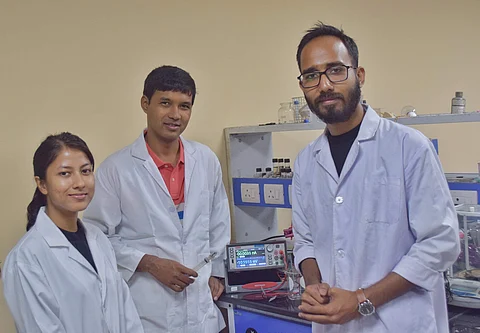

As many studies and natural disasters (the Australian wildfires in recent times is an example) have proved, the climate crisis is real and there is a pressing need to address it. One of the ways to tackle it is switching to renewable sources of energy. The generation of energy from water in various forms – river flow, ocean tides, stagnant water, and even raindrops, is now known as blue energy. While hydroelectric power from rivers is the traditional form of blue energy, there have been efforts to harness the power of water in other ways in recent years.
Using this principle, researchers at the Indian Institute of Technology Guwahati have developed materials that can produce energy from water, on a small scale. These new ways of producing energy can be employed in household environments to support the concept of decentralisation of energy sources. In the centralised energy generation model, one large plant produces energy for an entire region, in contrast, the decentralised energy model introduces a large number of small generation devices that can be employed to generate in every household. The excess energy produced in households can be transported nearby areas where there is an excessive need for energy.
The researchers of IIT Guwahati employed the nanoscale phenomenon called 'Electrokinetic streaming potential' to harvest energy from flowing water on a small scale like water flowing through household water taps. Similarly, different types of semiconducting materials were employed to generate power from stagnant water.
The research team was led by Dr Kalyan Raidongia, Department of Chemistry, IIT Guwahati, along with his research team consisting of Jumi Deka, Kundan Saha, Suresh Kumar, and Hemant Kumar Srivastava worked on this novel research. Their findings were recently published in ACS Applied Nanomaterials.
“When fluids stream through tiny channels that are charged, they can generate an electrical voltage, which may be harnessed through miniature generators”, explains Dr Raidongia. Although the exploration of such electrokinetic phenomena and their possible use for energy conversion have been known for more than half a century, they have not been harnessed because of low efficiency arising from the unsuitability of channels for the fluid stream. The humble efficiency of electrokinetic streaming potential based energy generating devices is attributed to the trade-off between high flow-rate and nanofluidic confinement. The researchers of IIT Guwahati demonstrated that power output can be improved by thousand times by attaining the best out of these parameters through biconical nanofluidic channels that interconnect tetrahedral and octahedral voids in the close-packed silica spheres. Enhancement in the power density can be brought about through control of multiple parameters such as the diameter of the close-packed spheres, number of the spheres, the contact area of the electrodes, and pH of the streaming water, and the team is currently involved in such optimisation efforts.
In order to extract power from stagnant water, devices were fabricated by employing doped graphene flakes. The complementary charge transfer activities of doped graphene flakes-based devices generate power just upon dipping in any kind of water source, like lake, river or seawater.
“We use a lot of stagnant and flowing water in our daily lives”, said Dr Raidongia. Water stored in buckets and water flowing from taps can potentially be used to produce energy if such nanogenerators can be developed further. While the power generated currently is too small for practical applications, research such as those by Dr Raidongia’s team brings us a step closer to realising simple, safe and reliable alternative power sources that can eventually reduce the load on the centralised grid, and contribute to energy self-sufficiency.
